
|
P4
So far we have described the Inductor as an
individual component. But when it is combined with a capacitor and whole new
world of magic is created.
As soon as this magic was discovered, the pioneers of electricity introduced
a whole new world of inventions and the new name was called ELECTRONICS..
It was found that when you deliver a pulse of energy to a coil and capacitor
in parallel, the capacitor controls the rate at which the inductor
discharges and it no-longer gives the high spike but discharges smoothly
into the capacitor and when all the energy has left the inductor, the
capacitor is fully or nearly fully charged. And now another amazing thing
happens, which no-one can explain. The capacitor begins to discharge into
the coil (inductor) and the inductor produces a magnetic field. It does this
until the capacitor is fully discharged. When the capacitor is fully
discharged, the magnetic filed on the inductor starts to collapse and
produce a voltage in the opposite direction and the capacitor charges in the
opposite direction.
This action goes back and forth many times and each time a little bit of
energy is lost. This means the amplitude of the waveform is decreased. But
if you deliver a little bit of energy at the right time, the waveform will
be maintained.
This is the principle of an oscillator and the shape is very smooth and
conforms to a sine wave.
This is what we will study now:
THE TUNED CIRCUIT
The TUNED CIRCUIT also called the PARALLEL RESONANT CIRCUIT or
TANK CIRCUIT and the two components that make up this arrangement called
PASSIVE devices. In other words they are not active (amplifying) devices
such as transistors and each component by itself cannot amplify, but when
they are placed together, they perform an amazing feat. They AMPLIFY a
signal (a pulse) delivered to them and turn the pulse into a natural curvy
waveform called a sinewave.
The two components we are talking about are: a coil
and a capacitor.
When they are placed in parallel, they produce a circuit
that has a natural frequency of oscillation.
Depending on where it is placed in a schematic (circuit
diagram), it can be called a RESONANT CIRCUIT or TANK CIRCUIT. TANK
CIRCUIT is reserved for its placement in the output of a transmitter, where
the effect of the circuit is to store energy (like a tank of water) that has
been delivered in short bursts and deliver it over a long period of time.
Before we go into the discussion it's best to see the coil and capacitor in action. Watch the animation below and see the "charges of electricity" moving from the capacitor to the coil and back again. It's the time take to charge the capacitor and then go to the coil to produce magnetic flux, that creates the gradual rise and fall (voltage rise and fall) across the combination.
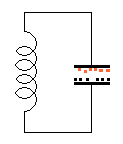
THE TUNED CIRCUIT

To start the circuit into operation, a short burst of energy has
to
be applied. This has not been shown in the animation above, but
if you mouseover the frame opposite it will be pulsed with a burst of energy. The energy from the pulse goes into the
capacitor
because it is uncharged and readily accepts the pulse. The coil,
on the other hand, has a characteristic called IMPEDANCE and
this prevents it from accepting the initial burst of energy.
It only likes to receive energy at an initial SLOW RATE and
that's why it accepts the energy LATER in the cycle, as shown
above.
This is an amazing effect for two seemingly simple components and is one of the earliest phenomena to be discovered. Without it, electronics would never have got off the ground; certainly not in the radio field.
It is the basis of all transmitters as well as many other types of radio circuits. The name "Tank Circuit" came from ham radio operators who used a coil and capacitor in the output of their transmitters to improve the output. The circuit stores bursts of energy from the output stage like a tank and delivers it smoothly to the antenna.
The way it does this is the energy is firstly passes into the capacitor. The energy (the voltage) is also presented to the coil and it is converted to magnetic flux. This flux cuts the turns of the coil and produces a voltage that is of opposite polarity and this has the effect of pushing against the incoming voltage. That's why the capacitor is first to receive the energy.
As it charges, the coil gradually begins to accept a flow of energy and since the coil has a very low resistance, it eventually takes over to take the charge from the capacitor.
The coil converts the energy into magnetic flux and this is passed to the surrounding air or into the core material of the coil. While the coil is receiving energy and producing magnetic flux, the flux is called EXPANDING FLUX. But the capacitor soon runs out of energy and the flux cannot be maintained.
The flux surrounding the coil COLLAPSES and produces COLLAPSING FLUX and the magnetic flux lines cut the turns of the coil to produce a voltage (and current) in the coil that IS OPPOSITE POLARITY to the original voltage.
Refer to the animation above and see the energy coming out of the coil is opposite to that entering it. This is one of the amazing features of a coil and you can see the capacitor being charged in the OPPOSITE DIRECTION by the coil.
When the magnetic lines fully collapse, the capacitor is fully charged (but slightly less than before due to the losses in the circuit) and the cycle repeats, this time with the voltage from the capacitor in the OPPOSITE DIRECTION to the original charge.
This action will repeat a number of times. Each time the amplitude of the voltage will be slightly less (due to losses in the circuit).
All it requires is the initial pulse to be presented to the circuit AT THE CORRECT TIME and the circuit will repeat its transfer of energy form coil to capacitor and back again.
This is done by a circuit monitoring the waveform and turning on at exactly the correct instant so that the losses are replaced and the full amplitude is maintained.
The result is a sinewave that can have an amplitude greater than the applied voltage. This is amazing and is due to the collapsing magnetic flux producing a voltage that is higher than the delivering voltage. The voltage mainly depends on the speed at which the field collapses. If this voltage is double the applied, the quality factor or "Q" factor is 2. If the voltage is 10 times, the Q factor is 10.
Some parallel resonant circuits can have a Q factor of 20, 50, 100, 500 or more. It all depends on the coil and the percentage of energy tapped off for monitoring etc and the speed with which the coil is allowed to collapse. .
The tuned circuit is very important. Even though it appears to be very simple, it takes a lot of skill to design the correct Q.
The physical size of the coil and capacitor must be worked out as well as the correct value and placement of the parts as the current that circulate between the two can be higher than the current entering the circuit!
A high Q arrangement is required in a receiver to obtain good selectivity - so that adjacent stations can be separated from one another. A low Q will cause them to come through in a jumble.
A tank circuit in the output of a transmitter will have a low Q as most the energy will be transferred to the antenna during each cycle and its main function it to match the output stage to the antenna,
rather than provide a high Q factor.
The animation below shows the voltage across the combination is changing direction very quickly to produce a SINEWAVE. This is shown on the CRO (Cathode Ray Oscilloscope).
This piece of test-equipment is now called a DSO (Digital Storage Oscilloscope). The waveform on the CRO will be stationary when it is set-up correctly. The red line on the screen indicates the peak, zero and minimum values of the waveform and these correspond to the voltage on the capacitor at different points in the cycle.

Here is a circuit that shows a TUNED CIRCUIT connected to a transistor.
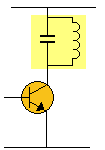
The transistor provides a small amount of energy at exactly the right
time to keep the circuit oscillating.
We have said the coil does not produce a very high voltage because it is
being delivered energy in a smooth way by the capacitor and the
capacitor only allows the coil to pass energy to it in a
smooth way. This results in a waveform that is a sinewave.
But the amazing part is the coil produces a voltage in the opposite
direction when the magnetic flux is collapsing (and passing the energy to
the capacitor).
This part of the cycle occurs when the transistor is turned OFF and thus
you can consider it to be absent as shown in the following circuit:
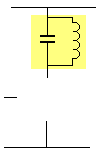
I am not going into any complex discussion. But here's the fact:
Because the voltage emerging from the coil is in the opposite direction
to the charging-voltage, the voltage at the bottom of the tuned circuit
is HIGHER than the supply voltage and thus this circuit will produce a
waveform that is about TWICE the supply voltage.
Suppose the supply is 5v. The voltage at the bottom of the TUNED
CIRCUIT will range from 0v to five volts higher than the supply and
that's how it becomes a 10v "swing."'
MORE ON: HOW THE TANK CIRCUIT WORKS
This is an "in-depth" description of how the Tank Circuit
delivers the energy from the capacitor to the coil (inductor)
and then back to the capacitor.
The "secret" of its operation has never been described before
and all discussions have glossed-over "how and when and why" the
capacitor gets fully discharged before the cycle starts again.
Suppose the capacitor is charged and is placed across the
inductor. Current will flow into the inductor and produce
magnetic lines of force in the core that will cut all the other
turns and produce a voltage in these turns that is opposite to
the incoming voltage. This means the incoming voltage will see a
voltage produced by the inductor that will be as high as 99% of
the incoming voltage. This means the incoming voltage will
appear as a very small voltage and it will increase the flux
lines very slowly.
The capacitor will keep supplying current but since the voltage
across it is reducing, the current will be reducing and thus the
flux will be expanding at a reduced rate. The back voltage
produced by the expanding flux depends on the rate of expansion
and since this expansion is getting less, the back voltage is
reducing.
The amazing thing is this: as the voltage of the capacitor
decreases, the back voltage decreases and the current increases.
I can explain it this way.
Suppose you put a 9v battery across the coil, after a short time
the flux will be a maximum but it will not be expanding flux and
inductor will produce the maximum flux and take the maximum
current.
When the capacitor is almost fully discharged, the current will
be a maximum and because the flux is not expanding, there will
be no back voltage.
So a point comes when the capacitor has no voltage across it and
the inductor produces no voltage.
This is the secret to how the oscillator works.
Because the inductor has a very small resistance, it only takes
a very small voltage to deliver a very high current and produce
a very large amount of magnetic flux. But eventually this small
voltage cannot maintain the flux and all the voltage and
current-capability is taken from the capacitor.
At this point in the cycle, the flux cannot be maintained and it
starts to collapse. As it collapses, it can only produce a
certain amount of current and this current charges the
capacitor. In other words the capacitor controls the rate of
collapse of the inductor and the voltage across the capacitor
gradually increases.
In actual fact, the inductor "can and will" produce a very large
voltage during a collapse if nothing is connected to it and this
is called a fly-back voltage.
But since a capacitor is connected, the voltage can only rise as
the capacitor allows it to rise.
So it rises until the flux has almost fully collapsed and even
at this point the collapsing flux is able to produce a voltage
much higher than the voltage across the capacitor and that's why
it can keep charging the capacitor right up to the point when
the flux has almost completely collapsed.
That's why the capacitor gets charged to almost the original
voltage.
Even the tiniest amount of flux will produce a charging voltage.
But eventually the flux is zero and the voltage across the
capacitor sees the inductor as a very small resistance and it
starts to deliver a current. This current produces magnetic flux
in all the turns of the winding and each turn produces a back
voltage so that the actual magnetizing voltage is very small and
thus only a very small current flows to create the second cycle.
THE SECRET
Here's the reason why the capacitor is able to deliver all
its energy to the coil:
As the voltage across the capacitor decreases, the coil can only
produce a back voltage that is slightly less than the capacitor
voltage. That's why the energy keeps flowing from the capacitor
to the inductor. It is only when the capacitor cannot deliver
any more current, that the circuit starts to change direction.
Just before this occurs, the voltage of the capacitor can be
very small because the resistance of the inductor comes into
play since the back-voltage is very small and it is the
back-voltage that turns the resistance of the coil into an
inductance. Now we have a very small capacitance voltage being
able to deliver a high current into a small resistance to
maintain the magnetic field.
Only when this voltage finally reduces to almost zero, does the
circuit start to change direction.
Now, going back in the other direction, why is the inductor able
to keep charging the capacitor when it is nearly out of magnetic
flux?
The reason is this. If the capacitor was not connected,
the inductor would be able to produce a very high voltage when
the magnetic field is collapsing because the size of the
back-voltage depends on the speed of the collapsing field. Even
when the inductor is almost out of flux, it can produce a very
high voltage when nothing is connected to it. That is: when no
capacitor is connected, it will collapse very fast and produce a
very high voltage.
So, it is the capacitor that is controlling this voltage, BUT it
is always slightly higher than the voltage across the capacitor
so the charging keeps occurring until the inductor is finally
out of flux.
Don't forget, when the magnetic field of the inductor is
collapsing, the voltage it is producing is in the opposite
direction to the original voltage.
This means the capacitor gets charged in the opposite direction.
In the diagram above, the top rail is the supply rail and the
bottom rail is connected to a transistor.
If we connect a multimeter or digital CRO to the transistor, we
will see the voltage reduce lower than rail voltage during half
the cycle and then become higher than rail voltage during the
second half of the cycle.
This means the effective voltage at this point is TWICE RAIL
VOLTAGE. The Tank Circuit can double the supply voltage !!
One reader asked what would happen if the inductor was much
larger than the capacitor.
The circuit would technically become a FLYBACK SUPPRESSION
circuit. Such as a capacitor across the coil of a relay.
But if you put these two in a tuned circuit (tank circuit) the
inductor would charge the capacitor to a very high voltage but
when the transistor turns on to inject a small amount of energy
into the circuit to produce the next cycle, the capacitor would
have a very high voltage across it and the energising voltage
would be much lower and there would be a clash of voltages and
the energy in the capacitor would be passed to the energising
transistor and be lost.
That's why it is important to match the two components.
THE INDUCTOR IN A POWER SUPPLY
No complex discussion.
Just a simple explanation. The following diagram shows an inductor in a
power supply. This type of arrangement is now used in modern designs
because the inductor is large, expensive and takes up a lot of room.
However we are going to explain how it works and this knowledge applies
to the high-frequency switch-mode power supplies that use an inductor of
very small size and inductance.
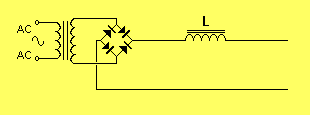
AN INDUCTOR IN A POWER SUPPLY
Basically, the waveform into the inductor is large and the output waveform is smaller. This only applies when a CURRENT IS FLOWING, so we will ad a LOAD.
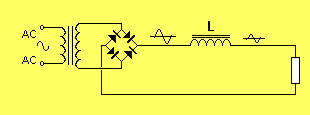
THE INPUT AND OUTPUT WAVEFORM
This is only a general discussion to help
you "see" how an inductor works.
We will add the smoothing electrolytics to the input and output of the
inductor, as it normal in a power supply.
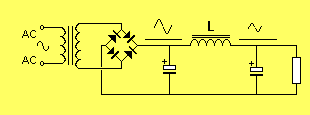
The inductor in a DC circuit
We will remove the first electrolytic to make the discussion easy to understand:
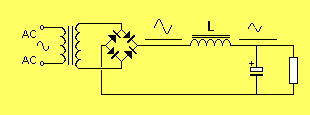
The inductor simply reduces the ripple. The electrolytics
perform 90% of the operation of storing energy to get a DC voltage with
a ripple. This ripple is only present when the LOAD draws a
current. (If the load is not present, you cannot detect the ripple.)
You can reduce the ripple by increasing the capacitance of each
electrolytic or adding an inductor. You would need very large
electrolytics to reduce the ripple and the inductor has this capability.
Now we are going to look at how the inductor reduces the ripple. The
ripple is noise or hum in the background of an amplifier and this can be
very annoying.
To explain how a component works, one lead must be fixed. This
gives a reference point of ZERO so you can see what the component
is doing.
But before we start you have to know there are two different types of
inductor. One for an AC circuit and one for a DC circuit (this circuit).
The one for DC circuit has an AIR GAP. The air gap is to absorb or
remove all the magnet lines of force that is produced by the coil when
the current is flowing. The magnetism flows into the air gap and does
not reach the other side. This means the magnetic path does not
get any magnetism. The magnetism is "lost" in the air gap.
This is hard to predict so a small air gap is provided so the magnetic
path gets some magnetism but is not saturated. You can increase the
width of the air gap later.
We now have an inductor that detects the ripple and the level of
magnetism in the core increases and decreases due to the ripple. The
magnetism from the DC current is already "lost.".
We take the circuit above and only consider the ripple. We consider the
output of the inductor to be fixed and does not rise or fall.
The incoming ripple will be converted to extra flux and will not appear
on the output. That's the purpose of the inductor. When the input
voltage increases, the magnetic field will increase and the additional
voltage across the inductor will be "absorbed" by the inductor and the
output lead will no increase (rise).
When the input voltage reduces, the magnetic field will
collapse and produce a voltage that adds to the incoming voltage and
thus the voltage across the inductor will increase by the same amount as
the decrease in input voltage and
thus maintain the output voltage will not alter.
The inductor has a very big effect on very small values of ripple such
as 20mV ripple being reduced to less than 1mV. That's why they were
used.
You can see how difficult it is to design the inductor. You don't
know the width of the air gap to remove most of the flux and only allow
the ripple portion to be processed in the core.
None of this is covered in any of the YouTube videos because the
instructors have never experimented with the circuit and have no idea
what they are talking about.
The are: "guilty by omissions." If you don't mention it, you
cannot be found guilty.
But that's not the way to teach. The pro's and con's of each design
needs to be covered so the student will not fall into any traps.
Fortunately, all power supplies have changed to switch-mode operation
and work at 150kHz where the components are 10 times smaller, rated at
higher current, cost one-tenth, are almost fail-proof and weigh a
fraction of the weight of a 50Hz supply.
That's why I have only covered this feature in a very brief way.
In any type of circuit using any type of inductor, there is only two
ways to approach the problem. Copy and use an inductor that is
already proven to be successful, or take a proven design and experiment
with different core sixes and winding and wire diameter to see if any
improvement can be obtained. Don't even think of putting pen to paper.
It is only by experimenting, can you get a component that will be
guaranteed to work. And you won't be embarrassed by getting 100,000
designed to your requirements and find they fail.
14/10/2023